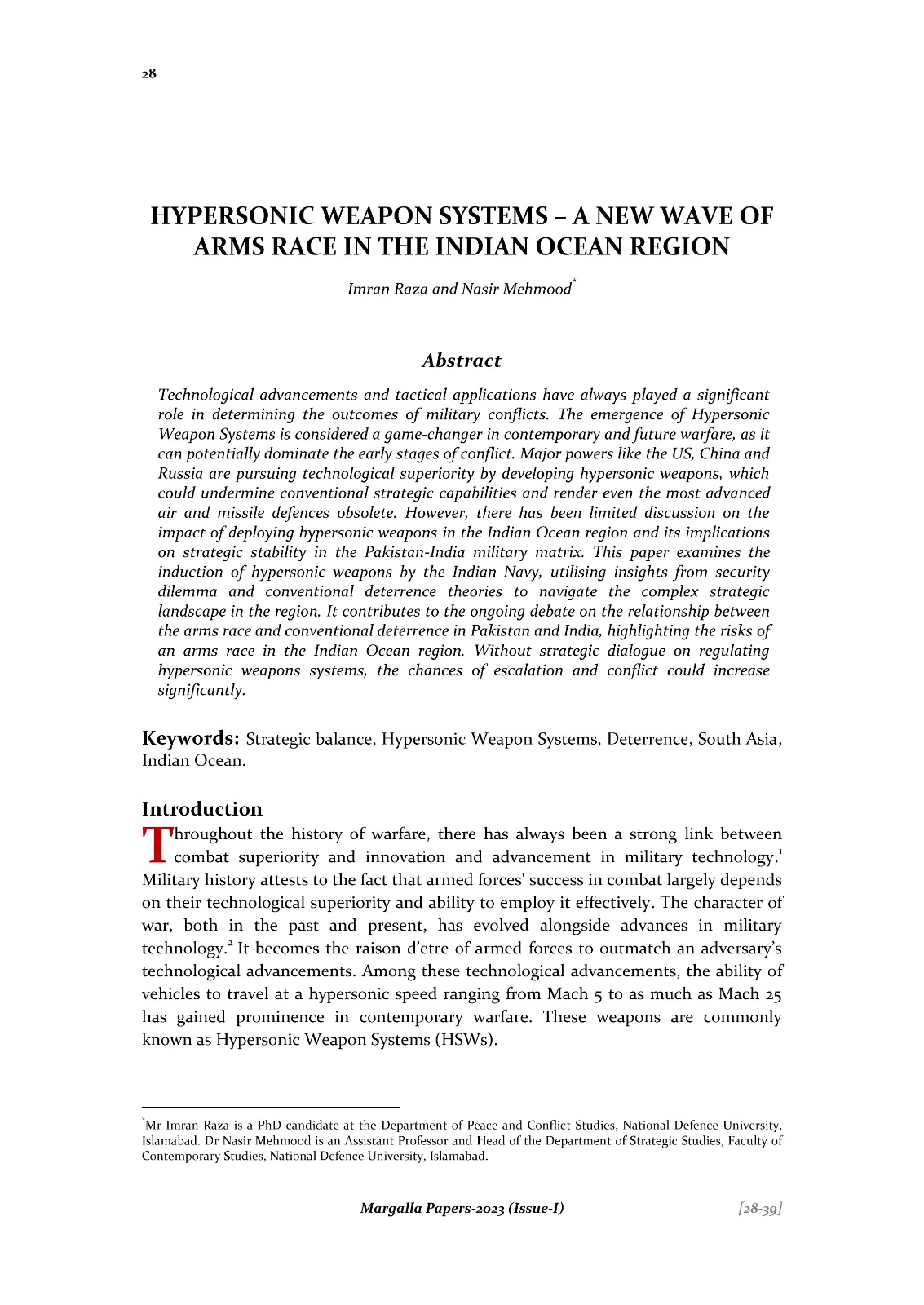HYPERSONIC WEAPON SYSTEMS – A NEW WAVE OF ARMS RACE IN THE INDIAN OCEAN REGION
DOI:
https://doi.org/10.54690/margallapapers.27.1.149Keywords:
Strategic Balance, Hypersonic Weapon Systems, Deterrence, South Asia, Indian Ocean.Abstract
Technological advancements and tactical applications have always played a significant role in determining the outcomes of military conflicts. The emergence of Hypersonic Weapon Systems is considered a game-changer in contemporary and future warfare, as it can potentially dominate the early stages of conflict. Major powers like the US, China and Russia are pursuing technological superiority by developing hypersonic weapons, which could undermine conventional strategic capabilities and render even the most advanced air and missile defences obsolete. However, there has been limited discussion on the impact of deploying hypersonic weapons in the Indian Ocean region and its implications on strategic stability in the Pakistan-India military matrix. This paper examines the induction of hypersonic weapons by the Indian Navy, utilising insights from security dilemma and conventional deterrence theories to navigate the complex strategic landscape in the region. It contributes to the ongoing debate on the relationship between the arms race and conventional deterrence in Pakistan and India, highlighting the risks of an arms race in the Indian Ocean region. Without strategic dialogue on regulating hypersonic weapons systems, the chances of escalation and conflict could increase significantly.
Bibliography Entry
Raza, Imran and Nasir Mehmood. 2023. "Hypersonic Weapon Systems – A New Wave of Arms Race in the Indian Ocean Region." Margalla Papers 27 (1): 28-39.
References
Michael J. Boyle, The Drone Age: How Drone Technology Will Change War and Peace (Oxford: Oxford University Press, 2020), 237. DOI: https://doi.org/10.1093/oso/9780190635862.001.0001
Thomas B. Gukeisen, The Operational Art of Blitzkrieg: Its Strengths and Weaknesses in Systems Perspective, 33.
Harlan K. Ullman, “Shock and Awe a Decade and a Half Later” Features PRISM 2, No. 1: 79-86; Risks, An Arms Control Association Report, September 2021, 4.
Daniel C. Sproull, “Kinetic Energy Weapons the Beginning of an Interagency Challenge,” Features Inter Agency Journal 8, no. 2, (2017): 63.
Anders Wivel, “Security Dilemma,” in International Encyclopedia of Political Science, eds., Badie Bertrand, Dirk Berg-Schlosser, and Leonardo Morlino (New York: Sage Publications, 2011), 2390.
John J. Mearsheimer, “Conventional Deterrence: An Interview with John J. Mearsheimer,” Strategic Studies Quarterly 12, no.4 (Winter 2018): 1.
Rodney Jones, Nuclear Escalation Ladders in South Asia, Report Number ASCO 2011 007 (Fairfax County: Virginia, Defense Threat Reduction Agency Advanced Systems and Concepts Office, 2011), 4. DOI: https://doi.org/10.21236/ADA555250
David M. Van Wie, “Hypersonic: Past, Present, and Potential Future,” Johns Hopkins APL Technical Digest 35, no. 4 (2021): 338.
Michael Krepon, Travis Wheeler, and Shane Mason, The Hure & Pitfalls of MIRVs: From the First to the Second Nuclear Age (Washington: Stimson Center, 2016), 14.
John Borrie, Amy Dowler, and Pavel Podvig, Hypersonic Weapons, A Challenge and Opportunity for Strategic Arms Control (New York: United Nations Office for Disarmament Affairs, 2019), 9. DOI: https://doi.org/10.37559/WMD/19/Hypson1

Downloads
Published
How to Cite
Issue
Section
License
Copyright (c) 2023 Imran Raza; Nasir Mehmood

This work is licensed under a Creative Commons Attribution-NonCommercial 4.0 International License.












